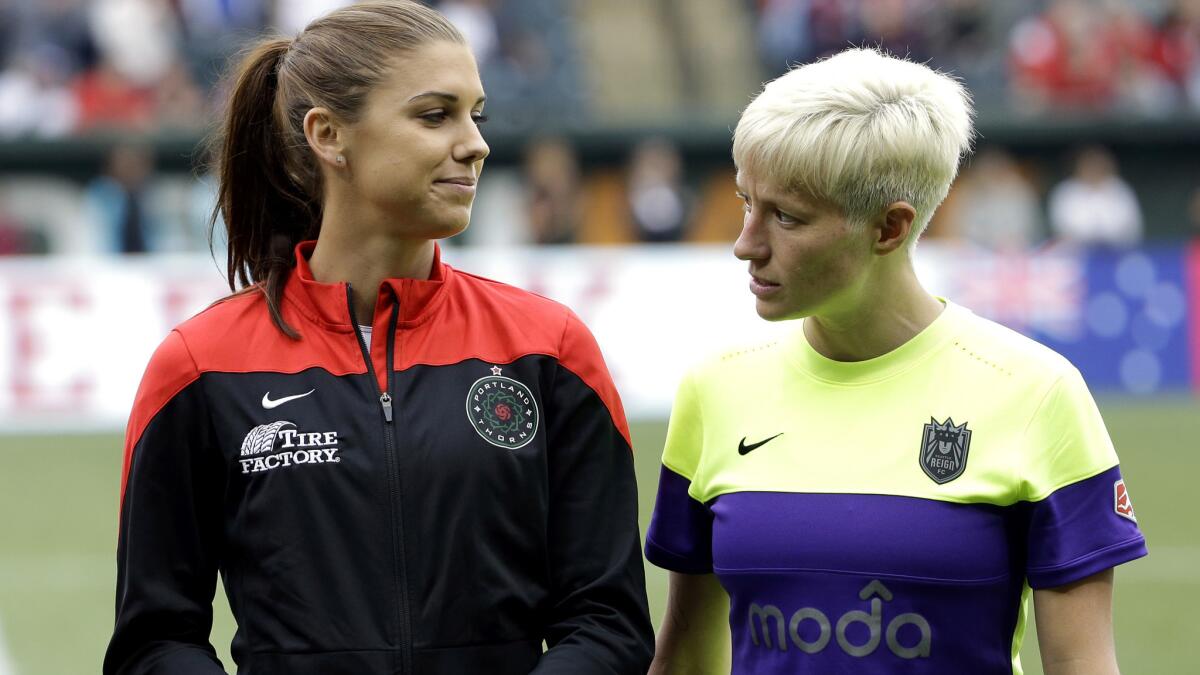U.S. women’s soccer needs investment in domestic league

- Share via
When the U.S. women’s national team opened its five-game “Victory Tour” last week at the Rose Bowl, I was disappointed as I watched the match on television.
I wasn’t disappointed in the result — a 3-0 win over Ireland — but that more people didn’t attend or at least know about it. Sure, it was an exhibition, but it was poorly promoted and marketed and the Rose Bowl looked empty as the game began. The women deserved better coming off their World Cup victory, but what’s new?
Every player on the U.S. women’s national team plays in the National Women’s Soccer League, which is the premier professional women’s league in the United States and was established in 2012. It has now been around longer than its predecessors, the Women’s United Soccer Assn. (2001-03) and Women’s Professional Soccer (2007-12), but it’s understandable if you’re still not familiar with it.
Most of the games in the nine-team league aren’t on television and can only be streamed on Yahoo Sports. There currently isn’t a team in California, Nevada or Arizona. The closest team to Los Angeles is in Utah. Chances are you’re not going to stumble upon an NWSL game if you live out here, but that could be changing. Last month, ESPN announced it would broadcast 14 matches, including the playoff semifinals and final, and Budweiser signed a multiyear sponsorship deal with the league.
“Like with every professional league, you need to have that support of sponsors and TV partners to grow the league and help it succeed,” said Julie Ertz, a midfielder for the national team and the Chicago Red Stars. “We had amazing turnouts for our first NWSL games when we came back, and now we just need to build off that.”
The problem in the past has been that the World Cup players are soon forgotten when they return to their club teams, plus the league gets little to no attention from outlets that cover the national team.
“We won the World Cup, but it’s not because we play on our own when we’re not with the national team,” said Allie Long, a midfielder for the national team and Reign FC in Tacoma, Wash. “We have a league that’s one of the best in the world. It’s a league where you have national team players and players trying to make the national team. If people watched this World Cup and were inspired by us, they need to know that our league is crucial for anyone looking to be on the national team one day.”
Sign up for our soccer newsletter >>
Hopefully that will change with a new TV deal and sponsorship money that will increase the visibility of the league and make it easier for casual fans that regularly watch the national team to find their favorite players after the World Cup. The hardcore fans are already there. Despite poor marketing and advertising, the national team attracted 37,040 at the Rose Bowl last week and will likely break its attendance record for a friendly match, with more than 40,000 tickets already sold for its game against Portugal on Aug. 29 at Lincoln Financial Field in Philadelphia.
“I think we just need to change the narrative,” said Crystal Dunn, a defender for the national team and North Carolina Courage. “Don’t look at it like a donation. Look at it like an investment, and right now, we’re in this phase where we’re trying to get out from questions like, ‘Is women’s soccer worth it? Should we be investing in it?’ That shouldn’t even be a question anymore. We know the support is there for the national team, so there’s no reason why it shouldn’t be there for our domestic league.”
::
The Clippers will enter next season as one of the favorites to win the NBA championship following a blockbuster summer during which they landed Kawhi Leonard and Paul George. But five years ago the future of the star-crossed franchise was unknown after former owner Donald Sterling was banned from the NBA for life for racist remarks he had made during a recorded conversation.
Sterling’s downfall and the subsequent $2-billion sale of the team to Steve Ballmer will be chronicled in an upcoming 30 for 30 Podcasts series called “The Sterling Affairs.” The five-part series debuts Aug. 20 and is reported and hosted by ESPN senior writer Ramona Shelburne. Western Sound, a Los Angeles-based podcast production company, collaborated on the project with The Undefeated. The series includes interviews with many of the major figures in the saga, including Shelly Sterling, who says she still listens to the infamous tapes to this day. One of the more interesting stories comes from Donald Sterling’s lawyer at the time, Bobby Samini, who was in a room with Sterling and Ballmer during the trial over the sale of the team.
“At one point, Donald tells Steve Ballmer, ‘I’m curious about one thing,’ ” Samini recalls. “Ballmer said, ‘Of course, what’s the question?’ Donald looks at him and says, ‘You really have $2 billion?’ We all started cracking up, and Ballmer said, ‘Yes.’ Donald said, ‘You have $2 billion in cash?’ And Ballmer said, ‘Don’t worry, I have the money. I can call the bankers and they can verify the funds.’ Sterling starts laughing and he looks at him and goes, ‘That’s the stupidest thing I’ve ever heard in my life.’ Ballmer looks at him and says, ‘What do you mean?’ and Sterling says, ‘Why would anyone have $2 billion in cash? You should invest the money or pay off your debt. You’d be stupid to have that kind of cash.’ ”
::
Dennis Rodman was one of the more interesting characters in sports history and was prominently featured in the 30 for 30 piece on the Detroit Pistons’ “Bad Boys” era. Rodman will have a major role in “The Last Dance,” a 10-part 30 for 30 series on the 1990s Chicago Bulls that will debut next year. Rodman, however, will get his own 30 for 30 documentary, which will premiere Sept. 10 on ESPN. The film will be narrated by Jamie Foxx and chronicle Rodman’s Hall of Fame career and infamous exploits on and off the court.
::
After lacking an NFL team for more than 20 years, Los Angeles not only has two in the Rams and Chargers but has become the hotbed for pro football this time of year with both teams and the Dallas Cowboys holding training camps in the region. Cowboys owner Jerry Jones played a large role in helping return the NFL to the city and pushing for Stan Kroenke’s vision for a $5-billion stadium in Inglewood that will house the Rams and Chargers as well as NFL offices. Jones’ role in the Rams and Chargers being in Los Angeles is a reason why neither team has much of an issue with the Cowboys continuing to hold at least a portion of training camp in Oxnard, which is about a 30-minute drive from the Rams’ headquarters in Thousand Oaks. This is the eighth consecutive year the Cowboys have held training camp in Oxnard, and they’ve held all or part of camp in Oxnard 14 times since 2001. The Cowboys previously held training camp at Cal Lutheran, which now houses the Rams training facility, from 1963 to 1989. The team’s contract with the city of Oxnard is up this month, but there’s optimism the Cowboys will return next year. “I can see us coming back,” Cowboys executive vice president Stephen Jones said. “We love coming here.”
More to Read
Go beyond the scoreboard
Get the latest on L.A.'s teams in the daily Sports Report newsletter.
You may occasionally receive promotional content from the Los Angeles Times.







